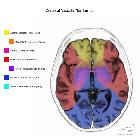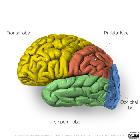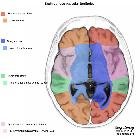middle cerebral artery (MCA)






The middle cerebral artery (MCA) is one of the three major paired arteries that supply blood to the brain. The MCA arises from the internal carotid artery as the larger of the two main terminal branches (the other being the anterior cerebral artery), coursing laterally into the lateral sulcus where it branches to perfuse the cerebral cortex.
Gross anatomy
Segments
The MCA is divided into four segments:
- M1: sphenoidal or horizontal segment
- originates at the terminal bifurcation of the internal carotid artery
- courses laterally parallel to the sphenoid ridge
- terminates either:
- at the genu adjacent to the limen insulae, where it makes a right angle turn
- at the main bifurcation
- M2: insular segment
- originates at the genu/limen insulae or the main bifurcation (see above)
- courses posterosuperiorly in the insular cleft
- terminates at the circular sulcus of insula, where it makes a right angle to hairpin turn
- M3: opercular segment
- originates at the circular sulcus of the insula
- courses laterally along the frontoparietal operculum
- terminates at the external/superior surface of the Sylvian fissure
- M4: cortical segment
- originates at the external/top surface of the Sylvian fissure
- courses superiorly on the lateral convexity
- terminates at their final cortical territory
Branches
M1
- medial lenticulostriate penetrating arteries
- lateral lenticulostriate penetrating arteries
- anterior temporal artery
- polar temporal artery
- uncal artery (which may branch from the anterior choroidal artery)
- orbitofrontal branch (same territory as orbitofrontal artery)
M2
Division of the MCA is variable after the horizontal segment, although most commonly, it divides into two trunks, superior and inferior:
- 78% bifurcate into superior and inferior divisions
- 12% trifucate into superior, middle and inferior divisions
- 10% branch into many smaller branches
Superior terminal branch
- lateral frontobasal artery
- prefrontal sulcal artery
- pre-Rolandic (precentral) and Rolandic (central) sulcal arteries
Inferior terminal branch
- three temporal branches (anterior, middle, posterior)
- angular artery
- two parietal branches (anterior, posterior)
Supply
The middle cerebral arteries supply the majority of the lateral surface of the hemisphere, except the superior portion of the parietal lobe (via the ACA) and the inferior portion of the temporal lobe and occipital lobe (via the PCA). In addition, they supply part of the internal capsule and basal ganglia.
In its territory lie the motor and sensory areas excluding leg and perineum and auditory and speech areas.
Variant anatomy
- MCA duplication: reported incidence of ~1.5% (range 0.2-2.9%); parallels the main MCA and supplies the anterior temporal lobe
- accessory MCA
- MCA fenestration is rare with a report incidence of <1%
- early branching of the MCA-bifurcation/trifurcation occurs within 1 cm of its origin
Siehe auch:
- Arteria carotis interna
- Arteria cerebri anterior
- Basalganglien
- Gefäßversorgung Gehirn
- doppelte Arteria cerebri media
- Temporallappen
- akzessorische Arteria cerebri media
- lateral lenticulostriate penetrating arteries
- medial lenticulostriate penetrating arteries
und weiter:
- transalar herniation
- neuroradiologisches Curriculum
- arterielle Versorgungsgebiete des Gehirns
- medial lenticulostriate arteries
- lateral lenticulostriate arteries
- Alberta stroke program early CT score (ASPECTS)
- middle cerebral artery dot sign
- Heubner-Arterie
- Karotis-T
- Infarkt im Versorgungsgebiet der Arteria cerebri media
- MCA dot sign
- moyamoya staging (Susuki)
- sub insular bright spots
- Segmente Arteria cerebri media
- Grenzzoneninfarkt
- M2 Segment
- intrakranielle Arteriosklerose
- slow flow in MCA due to embolus
- middle cerebral artery variants
- Arterien von Kopf und Hals
- Arteriae centrales anterolaterales

 Assoziationen und Differentialdiagnosen zu Arteria cerebri media:
Assoziationen und Differentialdiagnosen zu Arteria cerebri media:





